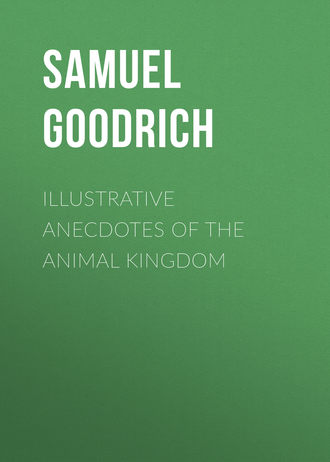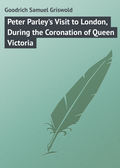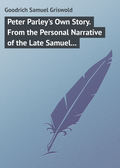
Goodrich Samuel Griswold
Illustrative Anecdotes of the Animal Kingdom
THE HERON
In Westmoreland, England, there were, some years ago, two groves adjoining a park, one of which, for many years, had been the resort of a number of herons; the other was occupied by rooks. At length, the trees tenanted by the herons, consisting of some fine old oaks, were cut down in the spring of 1775, and the young ones had perished by the fall of the timber. The parent birds immediately set about preparing new habitations to breed again; but not finding any other in the neighborhood high enough for them, they determined to effect a settlement in the rookery. The rooks made an obstinate resistance; but after a very violent contest, in which the herons finally triumphed, they built their nests and reared their young. The next season, the same contest took place; but victory declared, as before, for the herons. After this, peace was agreed upon, and they lived together in harmony in different parts of the same grove.
THE FLAMINGO
During the French revolutionary war, when the English were expected to make a descent upon St. Domingo, a negro, having perceived, at the distance of some miles, in the direction of the sea, a long file of flamingoes, ranked up and priming their wings, forthwith magnified them into an army of English soldiers; their long necks were mistaken for shouldered muskets, and their scarlet plumage suggested the idea of a military costume. The poor fellow accordingly started off to Gonalves, running through the streets, and vociferating that the English were come! Upon this alarm, the commandant of the garrison instantly sounded the tocsin, doubled the guards, and sent out a body of men to reconnoitre the invaders; but he soon found, by means of his glass, that it was only a troop of red flamingoes, and the corps of observation marched back to the garrison, rejoicing at their bloodless expedition.
ORDER VI.
PALMIPEDES,
WEB-FOOTED BIRDS.
THE GULL
Mr. Scott, of Benholm, near Montrose, many years ago caught a sea-gull, whose wings he cut, and put it into a walled garden, for the purpose of destroying slugs, of which these birds are very fond. It throve remarkably well in this situation, and remained about the place for several years. The servants were much attached to this animal, and it became so familiar that it came, at their call, to the kitchen door to be fed, and answered to the name of Willie. At length it became so domesticated, that no pains were taken to keep its wings cut; and having at last acquired their full plume, it flew away, and joined the other gulls on the beach, occasionally paying a visit to its old quarters. At the time the gulls annually leave that part of the coast, Willie also took his departure along with them, to the no small regret of the family, who were much attached to him. Next season, however, Willie again made his appearance, and visited the delighted family of Mr. Scott with his wonted familiarity. They took care to feed him well, to induce him, if possible, to become a permanent resident. But all would not do, for he annually left Benholm. This practice he regularly continued, for the extraordinary length of forty years, without intermission, and seemed to have much pleasure in this friendly intercourse. While he remained on that part of the coast, he usually paid daily visits to his friends at Benholm, answered to his name, and even fed out of their hands.
One year the gulls appeared on the coast, at their ordinary time; but Willie did not, as was usual, pay his respects immediately on reaching that neighborhood – from which they concluded that their favorite visitant was numbered with the dead, which caused them much sorrow. About ten days after, during breakfast, a servant entered the room exclaiming that Willie had returned. The overjoyed family, one and all of them, ran out to welcome Willie; an abundant supply of food was set before him, and he partook of it with his former frankness, and was as tame as a domestic fowl. In about two years afterwards, this bird disappeared forever. The above facts are confirmatory of the great age which the gull has been said to attain.
THE CORMORANT
It is well known that this bird is taught by the Chinese to fish for them. A gentleman of Scotland some years ago obtained two young ones, which he succeeded in domesticating. They soon learned to fish on their own account, and when satisfied, would amuse themselves by quitting and retaking their prey. They sometimes remained for a whole day on board of ships when they were kindly treated, and when these sailed, they would accompany their friends to sea for a few miles. They were very familiar, but would not submit to be teased. When shot at, they always flew to the first person they saw belonging to their master's family, for protection. Their owner had their heads painted white, in order to distinguish them from the wild ones with whom they frequently associated.
THE SWAN
At Abbotsbury, in Dorsetshire, there was formerly a noble swannery, the property of the Earl of Ilchester, where six or seven hundred were kept; but from the mansion being almost deserted by the family, this collection has of late years been much diminished.
A female swan, while in the act of sitting, observed a fox swimming towards her from the opposite shore. She instantly darted into the water, and having kept him at bay for a considerable time with her wings, at last succeeded in drowning him; after which, in the sight of several persons, she returned in triumph. This circumstance took place at Pensy, in Buckinghamshire.
THE GOOSE
Miscellaneous Anecdotes.– "An old goose," says an English writer, "that had been for a fortnight sitting in a farmer's kitchen, was perceived on a sudden to be taken violently ill. She soon after left her nest, and repaired to an outhouse, where there was a young goose, which she brought into the kitchen. The young one immediately scrabbled into the old one's nest, sat, hatched, and afterwards brought up, the young goslings as her own. The old goose, as soon as the young one had taken her place, sat down by the side of the nest, and shortly afterwards died. As the young goose had never been in the habit of entering the kitchen before, it is supposed that she had in some way received information of the wants of the sick goose, which she accordingly administered to in the best way she could."
An English gentleman had some years ago a Canadian goose, which attached itself to a house dog. Whenever he barked, she cackled, ran at the person the dog barked at, and bit his heels. She would not go to roost at night with the other geese, but remained near the kennel, which, however, she never entered, except in rainy weather. When the dog went to the village, the goose always accompanied him, contriving to keep pace with him by the assistance of her wings; and in this way she followed him all over the parish. This extraordinary affection is supposed to have originated in the dog having rescued her from a foe in the very moment of distress.
Captain L., of New Jersey, while lying at anchor with his schooner off Poole's Island, in the Chesapeake Bay, observed a wild goose, which had been wounded, attempt to fly from the top of a hill to the water; but being unable to reach its place of destination, it alighted about midway down the hill, where some cattle were grazing; one of which, seeing the stranger, walked up, as is commonly the case, to smell it. The goose, not fancying this kind of introduction, seized the ox by the nose with so much firmness as to set the creature bellowing; and he actually ran off a considerable distance before he could disengage the goose from its hold.
CLASS III. REPTILIA … REPTILES
This is a class of animals between birds and fishes, generally crawling or swimming, of a cold temperature, sluggish habits, slow digestion, and obtuse senses. They include serpents, lizards, tortoises, frogs, toads, salamanders, the proteus and siren. The reptilia are divided into four orders, the division being founded upon the difference in the quantity of their respiration, and the diversity of their organs of motion.
ORDER I.
CHELONIA,
TORTOISE
These animals are of various sizes, some living on the land, and some on the sea. They are remarkable for longevity. Mr. Murray says, "The size to which this creature occasionally attains is quite monstrous. I remember, some years ago, to have seen one, then semi-torpid, exhibited near Exeter 'Change, London, which weighed several hundred weight. Its shell was proportionably thick, and its other dimensions bore a corresponding ratio. It was stated to be about eight hundred years old."
ORDER II.
SAURIA,
LIZARDS
The more formidable species of this tribe are inhabitants of the warmer countries of the globe. The larger kinds prey upon animals, the smaller upon insects.
THE CROCODILE
This animal is found on the banks of the Nile, Niger, and Ganges.
In crossing the Ba-Woolima, Mungo Park's attendant, Isaaco, met with a strange and nearly fatal adventure. In attempting to drive six asses across the river, just as he had reached the middle, a crocodile rose close to him, and instantly seizing him by the left thigh, pulled him under water. With wonderful presence of mind, he felt the head of the animal, and thrust his finger into its eye. This forced it to quit its hold: it soon, however, returned to the charge, and, seizing him by the other thigh, again pulled him under water. Isaaco had recourse to the same expedient, and thrust his fingers a second time into its eyes with such force, that it again quitted him, rose to the surface, floundered about as if stupid, and then swam down the stream. Isaaco, in the mean time, reached the bank of the river, bleeding very much – the wound in his left thigh being four inches long, that on the right somewhat less, but very deep, besides several single teeth-marks on his back. In six days, however, he recovered so as to be able to travel.
At Chantilly, in France, there was, in the year 1828, a crocodile so perfectly tame and well-disposed, that he was caressed with impunity by the keeper, who endeavored, although not always with success, to induce visitors to follow his example. He never attempted to bite any one, but seemed pleased by being fondled.
THE ALLIGATOR
This creature is similar in habits and appearance to the crocodile. It is found only in America, and is most abundant in the tropical regions. The anecdotes which display its ferocity are numerous; but we choose one which exhibits it in a different character. Mr. Jesse had one which he made so perfectly tame, that it followed him about the house like a dog, scrambling up the stairs after him, and showing much affection and docility. Its great favorite, however, was a cat; and the friendship was mutual. When the cat was reposing herself before the fire, the alligator would lay himself down, place his head upon the cat, and in this attitude go to sleep. If the cat was absent, the alligator was restless; but he always appeared happy when puss was near him. The only instance in which he showed any ferocity was in attacking a fox, which was tied up in the yard. Probably, however, the fox had resented some playful advances which the other had made, and thus called forth the anger of the alligator. In attacking the fox, he did not make use of his mouth, but beat him with so much severity with his tail, that, had not the chain which confined the fox broken, he would probably have killed him. The alligator was fed on raw flesh, and sometimes with milk, for which he showed great fondness. In cold weather, he was shut up in a box, with wool in it; but having been forgotten one frosty night, he was found dead in the morning.
THE SALAMANDER
Recently, as David Virtue, a mason in Scotland, was dressing a heavy barley millstone from a large block, after cutting away a part, he found a lizard of this species imbedded in the stone. It was about an inch and a quarter long, of a brownish-yellow color, and had a round head, with bright, sparkling, projecting eyes. When first found, it was apparently dead; but after being about five minutes exposed to the air, it showed signs of life. It soon became lively, and ran about with much celerity; and about half an hour after the discovery, was brushed off the stone, and killed. When found, it was coiled up in a round cavity of its own form, being an exact impression of the animal. There were about fourteen feet of earth above the rock, and the block in which the lizard was found was seven or eight feet in the rock; so that the whole depth of the animal from the surface was twenty-one or twenty-two feet. The stone had no fissure, was quite hard, and one of the best which is got from the quarry of Cullaloe; the stone is reckoned one of the hardest in Scotland.
ORDER III.
OPHIDIA,
SERPENTS
This order of animals is greatly diversified in their size, color, and qualities. Some are but five inches in length, and others reach the enormous extent of thirty feet. Some are inoffensive, and others are in the highest degree venomous. They are in general regarded with horror by mankind, and a universal instinct seems to call upon us to destroy them.
Anecdotes.– Mr. Strohecker, of Pennsylvania, had a daughter three years of age, who, for a number of successive days, was remarked to leave home with a piece of bread in her hand, and go to a considerable distance. The mother's attention was attracted by the circumstance, who desired the father to follow the infant, and observe what she did with the bread. On coming up to her, he found she was busy feeding several snakes called bastard-rattlesnakes. He immediately took the infant away, and proceeded to his house for his gun, and on returning killed two of them at a shot, and another a few days afterwards. The child called these reptiles, in the same manner as chickens are called; and when her father told her she would certainly be bitten by them if she attempted it again, she innocently replied, "No, father, they won't bite me; they only eat the bread I give them."
It has been a common opinion that serpents possess a peculiar power of fascination. This is probably a vulgar error; yet the following story is told of the daughter of a Dutch farmer near Niagara. It was on a warm summer day that she was sent to spread out wet clothes upon some shrubbery near the house. Her mother conceived that she remained longer than was necessary, and seeing her standing unoccupied at some distance, she called to her several times, but no answer was returned. On approaching, she found her daughter pale, motionless, and fixed in an erect posture. The perspiration rolled down her brow, and her hands were clinched convulsively. A large rattlesnake lay on a log opposite the girl, waving his head from side to side, and kept his eyes steadfastly fastened upon her. The mother instantly struck the snake with a stick; and the moment he made off, the girl recovered herself, and burst into tears, but was for some time so weak and agitated that she could not walk home.
ORDER IV.
BATRACHEA,
THE FROG KIND.
THE FROG
A Thief.– A correspondent of the Penny Magazine, who lived close to the outlet of a small lake, used to bestow a great deal of care and attention upon the rearing of young ducklings; but, after all, he had the mortification to find his efforts fruitless. The old ones would hatch fine healthy broods; but as soon as they were strong enough to waddle to a sedgy stream that issued from the adjoining lake, one or two daily disappeared, to the gentleman's great annoyance. Having suffered these continual depredations for two or three seasons, he one day noticed a nice duckling gradually disappear under the water; but judge of his surprise when he beheld a large bull-frog crawl out upon the prostrate trunk of a tree, with the duckling's feet still protruding from his capacious mouth! The mystery was thus solved; the bull-frogs had swallowed all the young ducks!
Curious.– Some years ago, the city of Metz was afflicted by one among the seven plagues of Egypt, namely, frogs; certain streets were filled with these animals, and no one was able to conjecture from whence they came, until it was explained by a dealer in frogs applying to the tribunals for the recovery of his property. He had shut up about six thousand frogs, designed for food, in a particular place belonging to the fish-market, where they were discovered by some children, who took part away to sell, and on leaving the troughs in the fish-market, forgot to close them. Profiting by the opening thus left, the frogs began to spread themselves in various parts, and even got into some of the neighboring houses, whose inhabitants found much difficulty in ejecting the unwelcome intruders.
An Escape.– A butcher in Glasgow found an ordinary-sized living frog in the stomach of a cow, which he had just killed. When laid down, it was full of spirit, and leaped about the slaughter-house, to the astonishment of a considerable crowd. The cow was killed between three and four o'clock in the afternoon; it was supposed she had swallowed the frog when drinking.
THE TOAD
Not the least wonderful part of the history of the toad is the circumstance of its being frequently found in the bed of solid rocks, and the internal cavities of trees.
Anecdotes.– We find it mentioned in the "Edinburgh Philosophical Journal," that "a specimen of a toad, which was taken alive from the centre of a solid mass of stone, has been sent to the College Museum of Edinburgh by Lord Duncan." It is mentioned, in the "Transactions of the Academy of Sciences," at Paris, that a live toad was found in the centre of an elm-tree, and another in an oak. Both trees were quite sound, and in a healthy condition. To these facts we may add another: It is related by Sir Thomas Dick Lauder, who is a close observer of nature, that, on his estate in East Lothian, a large toad was found in the heart of a smooth, straight beech-tree, at the height of thirty feet from the ground, where it was confined in a circular hole.
A gentleman who resided at Keswick, England, one evening in the latter end of July, observed a rustling among the strawberries in his garden, and on examining what it was, found that a toad had just seized a field-mouse, which had got on the toad's back, scratching and biting to get released, but in vain. The toad kept his hold, and, as the strength of the mouse failed, he gradually drew the unfortunate little animal into his mouth, and gorged him.
CLASS IV. PISCES … FISHES
Fishes are extremely numerous in species, and many of them are little known. They are found in every ocean, sea, lake, or river, – under the dreary skies of the poles, and the burning latitude of the tropics. Being the tenants of an element which excludes them from the familiar observation of man, we have fewer anecdotes of them than of those classes which we have already noticed. We shall therefore only attempt to present a few of the most striking that have come to our notice.
THE MACKEREL
The mackerel is one of the most voracious of all fishes; and when they get among a shoal of herrings, they make such havoc as frequently to drive it off the coast. Pontoppidan informs us that a sailor, belonging to a ship lying in a harbor of Norway, went into the water to wash himself, when he was suddenly missed by his companions. In the course of a few minutes, however, he was seen on the surface with vast numbers of mackerels fastened to him. The people went to his assistance in a boat, and tore the fishes from him; but it was too late; for he very shortly afterwards expired from the effects of the wounds he had received, and from the loss of blood.
THE SWORD-FISH
The extraordinary power of this fish is shown by the following statement, from the Penny Magazine: "In repairing his Britannic majesty's ship Leopard, in 1725, on her return from the coast of Guinea, a sword of this fish was found to have gone through the sheathing one inch, next through a three-inch plank, and, beyond that, four inches and a half in the firm timber. It was the opinion of mechanics that it would require nine strokes of a hammer weighing twenty-five pounds to drive an iron bolt, of similar size and form, to the same depth in the hull; yet this was accomplished by a single thrust."







